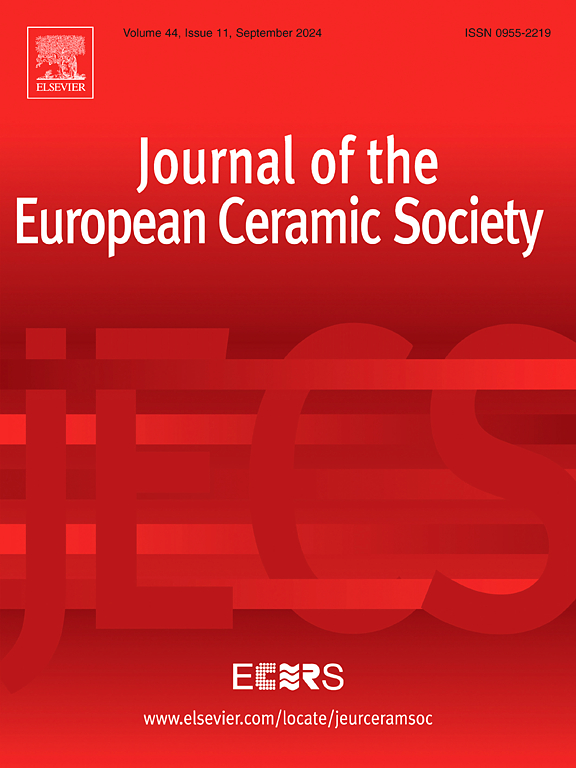Enhanced mechanical properties and oxidation resistance of (Ti,W,Mo,Ta)(C,N)-doped binderless Ti(C,N)-based ceramics
IF 5.8
2区 材料科学
Q1 MATERIALS SCIENCE, CERAMICS
Journal of The European Ceramic Society
Pub Date : 2025-05-26
DOI:10.1016/j.jeurceramsoc.2025.117543
引用次数: 0
Abstract
Binderless Ti(C,N)-based ceramics were fabricated via spark plasma sintering using Ti(C,N) and (Ti,W,Mo,Ta)(C,N) powders as starting materials. Thermal analysis results indicated that, compared with Ti(C,N) powders, the solid solution powders possessed higher activation energy for oxidation, reducing oxidation susceptibility during preparation and promoting densification during sintering. As the content of (Ti,W,Mo,Ta)(C,N) increased, the relative density and transverse rapture strength were continuously enhanced. The sample containing 80 wt % solid solution exhibited the highest hardness and fracture toughness. Additionally, the utilization of (Ti,W,Mo,Ta)(C,N) significantly enhanced oxidation resistance, which was attributed to its promotion of the anatase-to-rutile phase transformation of the oxidation products, owing to the incorporation of W, Mo, and Ta into the Ti(C,N). During the initial stage of oxidation, the oxidation products of (Ti,W,Mo,Ta)(C,N) rapidly transformed to rutile-type oxides with high stability. This mechanism inhibited volume changes and crack formation, resulting in dense and flat oxidized surfaces.
(Ti,W,Mo,Ta)(C,N)掺杂无粘结剂Ti(C,N)基陶瓷的力学性能和抗氧化性能增强
以Ti(C,N)和(Ti,W,Mo,Ta)(C,N)粉体为原料,采用火花等离子烧结法制备了无粘结剂Ti(C,N)基陶瓷。热分析结果表明,与Ti(C,N)粉末相比,固溶体粉末具有更高的氧化活化能,在制备过程中降低了氧化敏感性,在烧结过程中促进了致密化。随着(Ti,W,Mo,Ta)(C,N)含量的增加,相对密度和横向断裂强度不断提高。含有80 wt %固溶体的样品具有最高的硬度和断裂韧性。此外,(Ti,W,Mo,Ta)(C,N)的使用显著增强了氧化产物的抗氧化性,这是由于W,Mo和Ta在Ti(C,N)中掺入W,Mo和Ta,促进了氧化产物的锐钛矿到金红石的相变。在氧化初期,(Ti,W,Mo,Ta)(C,N)的氧化产物迅速转化为稳定性高的金红石型氧化物。这一机制抑制了体积的变化和裂纹的形成,导致致密和平坦的氧化表面。
本文章由计算机程序翻译,如有差异,请以英文原文为准。
求助全文
约1分钟内获得全文
求助全文
来源期刊

Journal of The European Ceramic Society
工程技术-材料科学:硅酸盐
CiteScore
10.70
自引率
12.30%
发文量
863
审稿时长
35 days
期刊介绍:
The Journal of the European Ceramic Society publishes the results of original research and reviews relating to ceramic materials. Papers of either an experimental or theoretical character will be welcomed on a fully international basis. The emphasis is on novel generic science concerning the relationships between processing, microstructure and properties of polycrystalline ceramics consolidated at high temperature. Papers may relate to any of the conventional categories of ceramic: structural, functional, traditional or composite. The central objective is to sustain a high standard of research quality by means of appropriate reviewing procedures.
 求助内容:
求助内容: 应助结果提醒方式:
应助结果提醒方式:


